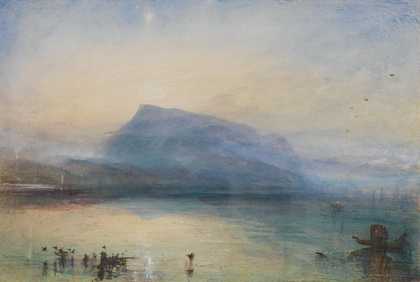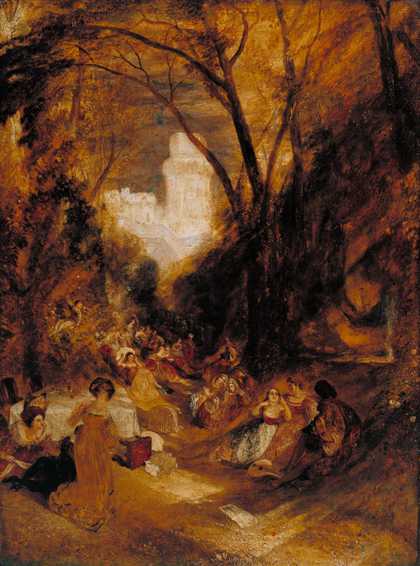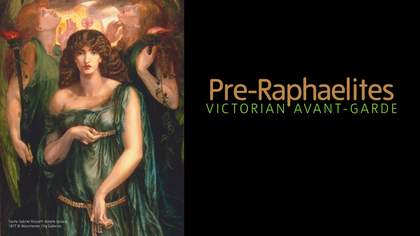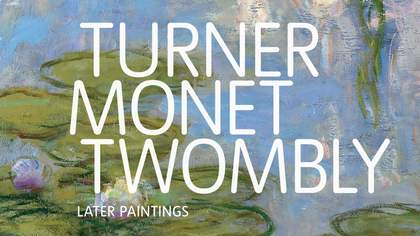Introduction

Fig.1
Turner’s ‘Chelsea’ palette, used at the end of his life
Tate Archive 7315.5
A comprehensive study of artists’ oil painting instruction manuals and handbooks published in Britain 1800–1900 has recently been published by Carlyle,1 entitled The Artist’s Assistant. This reviews virtually all the surviving literature on painting processes and materials which was aimed at professional artists and art teachers, and includes references to some of the more ephemeral literature aimed at amateur artists, decorators and tradesmen who used paint. The literature is covered very comprehensively and gives an excellent insight into what artists could have found out about their materials, had they cared to seek it out. Less is known, of course, about how much information each artist actually did seek out: inventories of studio contents at the artist’s death often give the best clues, for example, Turner’s includes his library contents.2
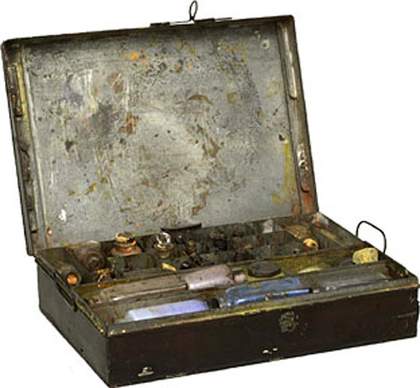
Fig.2
Turner’s paintbox, found in his studio after his death in 1851
Tate Archive 7315.6
Another rich source is the archives of artists’ colourmen, many of which survive from the earlier nineteenth century. The most notable and the largest of these is the Roberson archive, researched and described by Woodcock,3 which covers almost the whole century, and includes ledgers of materials bought and sold, accounts with individual artists, correspondence, and some working recipes for manufacture of paint mediums and varnishes. The Winsor & Newton archive has been discussed in terms of pigment history to mid-century by Harley,4 and in terms of pigments, canvas supports, oils, vehicles, and varnishes on sale from 1835 onwards by Carlyle.5 The less well-researched Reeves archive is discussed from c.1856 by Carlyle,6 and their watercolour materials as well as a paper archive are awaiting further study at the Museum of London. The colourman Berger has also been studied,7 and there are apparently no surviving archives for other nineteenth-century colourmen, some of whom were absorbed by the ‘big names’ mentioned above, when the fate of their archives became linked with the fate of the takeover company.
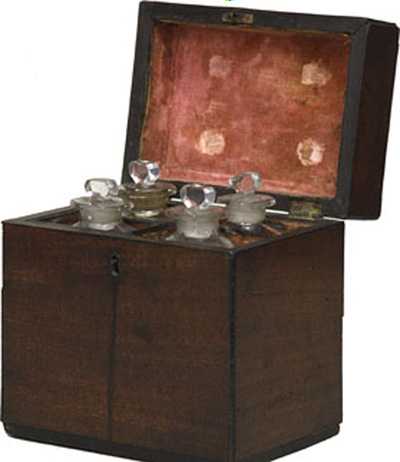
Fig.3
Small travelling chest, used by Turner to carry both paint mediums and medicine. The few remaining drops were analysed
See J. H. Townsend, ‘Turner’s use of materials, and implications for conservation’, in J. H. Townsend ed., Turner’s Painting Techniques in Context, London 1995a
Tate Archive 7315.8
Artists’ correspondence, diaries and unpublished papers offer tantalising glimpses of materials used, but unless they have been both published and critically assessed by a materials historian, the information is often hard to interpret. Such material is more of a primary resource for future research than literature which can be assimilated into general knowledge as yet. It is also hard to locate, especially when it belongs to family papers. In the future, such resources may be available in a form which can be searched on the World Wide Web, for example the Whistler archive at the University of Glasgow, which includes correspondence to and from the artist, accounts and notes.8 Woodcock has published a comprehensive list of artists’ (auto)biographies from 1820 into the twentieth century, though many of the books themselves are out of print or difficult to locate.9

Fig.4
Large travelling chest, used by Turner to store large supplies of dry pigment. The contents have been analysed
See J. H. Townsend, ‘The Materials of J.M.W. Turner: Pigments’, Studies in Conservation (SinC), no.38, 1993a
Tate Archive 7315.7
Information is available on a few artists. The wife of G.F. Watts published a good deal of information on him,10 and Millais’s son published Millais’ life and letters.11 Turner’s very meagre references to varnishing in his correspondence have been assessed and found to say very little about his preferences.12 In contrast, the diary of Ford Madox Brown is peppered with mentions of ‘Roberson’ and ‘copal’ which refer indiscriminately (and thus unhelpfully) both to unnamed paintings then being worked on, and to the artist’s thoughts generally on the subject.13
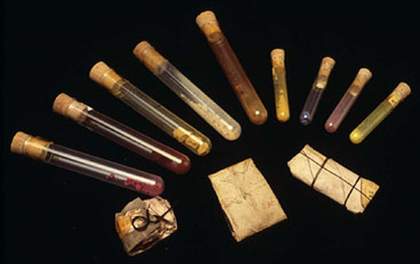
Fig.5
A selection of the sixty and more dry pigments found in Turner’s studio after his death. The contents have been analysed
Tate Conservation Archive Q04047
Another obvious resource is the surviving materials, which includes artists’ palettes as well as colourmen’s archives. Most are known only through publications which include their analysis, for example, two of Constable’s,14 one of Sargent’s,15 several of Turner’s (figs.1–5),16 and those in the Whistler archive mentioned above.17 All but the first of these publications include a colour illustration of each palette. There is no published database on the whereabouts of such materials, though researchers sometimes mention a palette in unpublished dissertations. In the UK, the Royal Academy of Arts, London, has the most extensive collection of palettes, since Academicians were encouraged to donate one apiece. National and private museums – especially those devoted to a single artist – public libraries, university museums, and conservation training programmes often house small amounts of well-provenanced artists’ materials.
The largest number of unpublished dissertations on the materials of British art can be found in the Conservation and Technology Department of the Courtauld Institute of Art, University of London, and the Straus Centre for Conservation, Harvard University, Boston, USA. They can be consulted by appointment, and in some cases represent the only significant study of a particular artist’s materials and techniques.
Supports and primings
Canvas was the support chosen for a definite majority of nineteenth-century paintings in the national collection for British art at Tate. Plain weave was mostly used. A significant proportion of works in this collection, perhaps 5–20%, have a panel support, or a more complex one involving paper or canvas on an auxiliary panel support, but the publications on the subject virtually exclusively cover canvas supports. Stretcher types and fibre type for British canvases are little discussed, but French ones have been described by Callen, whose monograph on French Impressionism includes one-to-one colour details of unprimed and primed canvases.18 They greatly resemble their British counterparts.
Canvas stamps have received considerable attention. When their style is correlated with the detailed history of the artists’ colourmen who supplied them, date ranges for the purchase of the canvas may be obtainable. Cobbe has produced the most comprehensive listing in print, for Winsor & Newton 1838–1920,19 and Butlin has covered Brown of High Holborn’s stamps as used by Turner c.1830–50,20 while others are in course of publication as a series of papers.21 An unpublished and growing database of canvas stamps for British colourmen, which was built on the work of Cobbe, exists at Tate.22 Later in the century, artists who travelled to Europe or the USA could have used local sources for canvas, and did, from anecdotal evidence. Some publications that document non-British colourmans’ products discuss French stamps23 and weave and fibre types,24 and another discusses supports from American colourmen.25 Stamps on individual paintings are occasionally mentioned, for example Roberson stamps,26 discussed in connection with textured primings. Some standard nineteenth-century canvas dimensions are tabulated by Carlyle27 and by Townsend.28 Studies of British artists’ materials exported to other countries give insights into trends in use: eg thread counts of 15 per centimetre, and canvas stamps occurring on only about 10 per cent of canvases, have been found on canvases painted in Japan with British materials,29 and their priming types have been studied.30 No comparable published studies exist for British paintings in the UK – though unpublished dissertations probably tabulate at least some of the information that could be used to clarify trends in the use of supports.
The literature on panels as supports all tends to concentrate on those from earlier centuries, when all panels were well crafted for their purpose. Anecdotal evidence suggests that nineteenth-century ones vary from well-crafted purpose-made ones to recycled rubbish. Terms for board supports have been discussed,31 as has the nineteenth-century use of academy and canvas boards, and millboards, in the UK,32 France33 and the USA.34
Supports and primings used by individual British artists have rarely been discussed in isolation, with the exception of Brett’s supports35 and Turner’s primings.36 As well as the composition of the priming, its absorbancy is a key feature of some artists’ technique, but it is discussed less often than its colour, which profoundly influences the appearance of a painting. Callen illustrates unpainted areas of canvas on a number of French Impressionist paintings, and discusses artists’ selection of canvas properties such as absorbency, texture, and the colour of the priming.37 Most information on primings is to be found in papers on the materials of a given artist, to be discussed in a later section.
Pigments
There is vast literature on artists’ pigments, which can only be summarised here. The best short summary is that of Gettens and Stout.38 The first third of the century has been well covered by Harley39 and the first edition of the much-edited Field’s Chromatography40 covers exactly the same period, from the viewpoint of a conscientious colourman. The manufacture, patenting and subsequent availability of the many pigments developed in the other two thirds of the century have not been clarified in such detail. Carlyle41 summarises information on pigments and colours found in artists’ manuals and handbooks, and lists colours sold by the colourmen Reeves, Roberson, Rowney and Winsor & Newton throughout the century, wherever these records survive: this gives potential availability, and an insight into the problems of colour change and incompatibility discussed at the time, but it is not yet matched by published experimental findings.
The assumption that every artist was keen to try out each newly-available material may not be justified. Turner did use new pigments soon after they became available,42 but where a first attempt has been made to relate earliest date of manufacture and earliest analytical finding of a given pigment43 there can be intervals of several decades. Further analysis may narrow these gaps, but it remains the case that some artists were wary of using untested pigments in important works. This has implications for dating within an oeuvre, and the detection of forgery, which have not been explored. Current methods of pigment analysis are well summarised within the conservation literature, though some papers do not include the keywords ‘paintings’ or ‘artists’ materials’ in the title.44
Distrust of the quality of nineteenth-century materials45 led to nineteenth-century experimental work on the stability of pigments. The Russell and Abney report46 The Action of Light on Watercolours and the oft-reprinted book by Church,47 The Chemistry of Paints and Painting, both published at the end of the century, echo modern texts on conservation science to a startling degree. More recent work has concentrated much more on the details of this vast subject than on such overviews.
The manufacture of pigments with poor lightfastness and/or inconsistent performance have been studied the most, for example madder48 whose manufacture and quality were developed and improved by Field the colourman,49 and Prussian blue.50 The Artists’ Pigments series covers the introduction, manufacture and detection of a number of nineteenth-century introductions in authoritative detail: cobalt, cadmium and chrome yellows,51 synthetic ultramarine,52 alizarin, emerald and Scheele’s greens, and chromium oxide greens.53 Many pigments are not yet covered in any depth, an exception being mummy,54 though some have been the subject of more popular books, such as Perkin’s mauve in the book of that name.55 There are very few studies that specifically cover instability or colour changes in pigments used in the nineteenth century, or by British artists. One exception is a study on the darkening of lead white by hydrogen sulphide.56
Paint, mediums and vehicles
Once again, Carlyle provides by far the most comprehensive source of information on paint formulation and use.57 Her study indicates that innovation, a desire to improve new materials, a wish to emulate historic ones, and frequent dissatisfaction with paint on the market were the norm: the manufactured painting materials of the nineteenth century were complex and ever-changing, and do not show any clear lines of development towards improved stability. A good but brief summary of the changing means of storing paint,58 from awkward bladders, through primitive syringes to easy-to-use tube paint, is also available. There are thorough studies (with short English summaries) of some specific materials: petroleum-based paints,59 asphalt,60 paint driers,61 and crack patterns attributable to materials.62
There are no published summaries of the types of oil found to have been used throughout the century. A summary of the findings from the sources listed below under ‘individual artists’ would indicate that predominantly linseed oil, but sometimes either walnut or poppyseed oil, was was used in the first half of the century; poppyseed oil was found in increasing preference to linseed oil when paint which came from tubes has been analysed.63 Paint which includes lead-based driers, or which has a more complex formulation, has generally been found to be linseed-based, when the oil type could be determined at all. Constable used fewer driers, and his oils have been found to be mainly poppyseed. Extensive tabulated analytical results for French paintings64 imply that poppyseed oil was very commonly used in French tube paints by the last decades of the century, and there is also supporting documentary evidence.65
Problems with interpretation of the literature: adulteration and poor quality control
Any artist who used tube paints – and nearly all of them would have used some from the 1860s, on account of their convenience and easy obtainability – could no longer choose which oil to paint with. It came provided, with driers to mitigate the slower drying of poppyseed and walnut oils compared to linseed, and of some pigments, and must also have been provided with other additives designed to stop the paint drying up hopelessly fast in the tube once it had been opened. Wax has been found, and attributed to the last reason – improved shelf life of the paint in tubes – in the materials of Whistler66 and the French-supplied materials of Puvis de Chavannes67 and the French Impressionists.68 Neither could the artist be sure that he/she was obtaining the pigments as stated on the tube, and artists’ manuals and books about paint from this period include much information for artists on how to test for adulteration of pigments in the studio, and which (normally cheaper and more susceptible to colour change) adulterants to expect.69
Hunt is the artist best known for complaining to his colourmen, at length and over decades, about the quality of their products.70 Townsend et. al.71 listed pigments which were substituted with others, colour names which had multiple identities, those which were often supplied with additives, and colours of the same name but different formulation in oil and watercolour media. Oils, resins, media, solvents, varnishes were also affected, according to the literature of the day.72 The problem was not confined to Britain: adulteration of materials was also perceived as a problem in Germany in the last decades of the nineteenth century.73
Varnishing practices
The most comprehensive source of varnish formulations and practice is Carlyle’s monograph.74 The same author has described the background to nineteenth-century varnishing practices.75 The use of a varnish-like material as an interlayer applied before later paint has been discussed briefly.76 Since the literature is so sparse for varnishes actually used by British artists, it is worth noting that the varnishing preferences of French artists,77 and van Gogh’s use of egg white varnishes78 have both been discussed in terms of their concerns over the glossiness or mattness of the varnished painting. G.F. Watts was unusual in his concern over the gloss of varnishes.79
White and Kirby80 have analysed the varnishes used on paintings in the National Gallery, London, during the nineteenth century. They note that mastic was the most popular varnish at mid-century, while dammar was scarcely used by 1850, a point also made by Carlyle81 and Mayer and Myers,82 though dammar was widely discussed just after that date. It was also first mentioned in Dutch sources in 1855, with mastic and volatile oil varnishes being mentioned most frequently at that time.83 White and Kirby’s analyses confirm the common occurrence of mastic, often as a spirit varnish and sometimes with (generally linseed) oil incorporated as a plasticiser. Mixed mastic and dammar varnishes, which may have been a consequence of adulteration, and mastic/copal varnishes were also found in that collection in the later nineteenth century; it could be seen that particular restorers used by the gallery favoured certain varnish types. Varnishes can only rarely be associated with a given artist, since there is evidence that other artists, or a restorer chosen by the purchaser, would often have been asked to varnish a painting for the first time, or to improve its appearance only a decade or two after painting.84 Nineteenth-century paintings were often varnished in the frame in the earlier part of their lives, as surface examination makes clear – a practice which makes sampling for the original varnish, or one which might match documentary evidence, more open to interpretation.
Framing practices
It is only in the 1990s that there has been much published on original frames, with illustrations. The choice of frame has always been important to presentation, but more importantly it reflects the later nineteenth-century artist’s intention. The context and development of portrait frames are well set out by Mitchell and Roberts85 who illustrate frames made by Brown for Rossetti, and selected by Rossetti, Whistler, Burne-Jones, Hunt, and Sargent, and in a catalogue by Simon.86 Some other frames have been illustrated in publications on the technical examination of individual works by Brett,87 Burne-Jones,88 Watts89 and Whistler.90 Nineteenth-century European and British frames including those for Alma-Tadema, Brown, Burne-Jones, Collins, Hughes, Hunt, Leighton, Moore, Rossetti and Whistler are illustrated by Mendgen,91 for the Pre-Raphaelites (Brown, Collins, Hughes, Hunt, Rossetti and Sandys) by Roberts,92 for later Victorian artists (Alma-Tadema, Burne-Jones, Drummond, Hunt, Leighton, Rossetti and Spencer Stanhope) by Roberts,93 and for Poynter by Sawicki.94 There is a good selection of drawings of frame mouldings used throughout the century by Mitchell and Roberts, in another publication.95 Photographic archives of frames exist in several British national galleries, and can be consulted.96
Studies on the properties and deterioration of nineteenth-century materials
Values have been published for the glass transition97 of the most common natural resin varnishes, a property that relates to their ability to retain dirt which has landed on the surface. This property, which would not have been understood in the nineteenth century, has been used to account for the excessive dirt retention of some oil-modified paint mediums.98
The melting points of various painting materials have been measured,99 and can be related to probable damaging effects of lining at too high a temperature, namely loss of impasto, running of one layer into another and darkening.100 Changes in appearance of Turner’s paintings, arising both from his choice of materials and from conservation treatments, have been summarised.101 Townsend102 has compiled published values for the refractive index of paint media and varnishes, a property which influences the transparency of the paint film.
It is only since the early 1990s that researchers have tried to make accurate reconstructions of nineteenth-century materials, to age them both artificially and naturally, to use the resulting material to further the understanding of deterioration in real paintings, and to develop techniques of analysis that are well-targeted towards aged and much-altered materials. Paint mediums103 modified by the addition of natural resins to form megilps,104 and copal-based mediums,105 as well as oil paints and mediums,106 have been reconstructed, aged and studied with a view to improving their detection in real paintings, and better understanding their optical properties. Measurements of their response to solvent cleaning,107 and their optical properties,108 have begun. More publications can be expected in these areas in the coming decade.
Studies of the chemical deterioration processes of oil-based paints must begin with studies of the chemistry of their drying: significant work has been published on the latter by Mills and White,109 and very recently by Sutherland,110 van den Ber,111 van der Brink112 and Languri et. al.113 Recent studies114 have focused as well on the chemistry of aged and discoloured natural resin varnishes.
Literature which discusses the materials of individual artists
The two most studied artists of the earlier nineteenth century are Turner and Constable. For Turner, his studio materials have been described, then115 revisited by Eastaugh116 for the red organic pigments, and by Townsend with a comprehensive summary of his use of supports and primings,117 as well as a summary of the pigments he used in oil and watercolour media throughout his life.118 Also described is his use of modified oil media, both in summary119 and in considerable analytical detail.120 The materials of some individual paintings have been discussed by a number of researchers.121 Cove has described a good cross-section of Constable’s materials, both pigments and media in paintings done over his lifetime,122 his media and the contents of a palette,123 and some individual paintings.124 His practice of retaining some paint from an earlier composition into a later one has also been described,125 as well as his sometime habit of modifying an earlier composition on the same support, wherein his materials were also analysed.126 Some further analyses of his media127 and techniques128 are available.
Far less published analytical information is available for other artists of the first half of the century: Cotman and Crome129 have been studied in some detail. The terms of reference of this paper exclude William Blake, who did not paint in oil medium. This author does not know of any published studies on the materials used by Callcott, Etty, Lawrence, Martin, Mulready, Leslie, Stansfield or Wilkie, to name some serious omissions.
At mid-century, the literature on individual artists seems sparse – until one realises how much less there is for later decades. Redgrave’s writings and a small number of his paintings have been studied.130 The Pre-Raphaelites131 have been researched far more than their conventional contemporaries, though predominantly in terms of what they wrote,132 rather than the materials they used in practice. (They were uniquely prolific diarists, among artists, and in any case far more documentary material seems to have survived after c.1850 than before, which partly accounts for this.) Technical examinations of individual paintings by Hunt,133 Millais134 and Rossetti are available,135 as well as findings for Brown, Collins and Hughes.136
Rather little has been published on British artists active after c.1860 in Britain. Exceptions include studies on Leighton,137 Sargent,138 Watts,139 and Whistler.140 There appear to be no technical studies of Alma-Tadema or Burne-Jones, to name but two establishment figures.
Very few exhibition catalogues published in the twentieth century include a sizeable technical entry based on analysis of materials. Cove on Constable is a notable exception.141 The recent trend towards the inclusion of such information in collections catalogues, such as that for the Huntington Library and Art Gallery,142 is very welcome. It seems likely that such information will be published on the World Wide Web in the future, under the web sites of individual museums, and possibly under the guise of a nineteenth-century artist’s website.
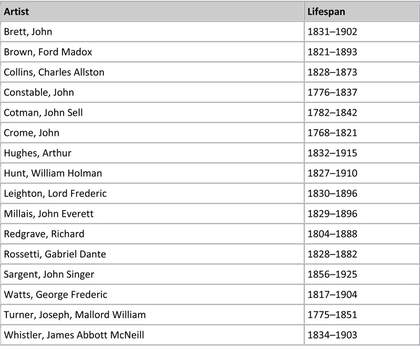
Table 1
British artists for whom published technical examinations are available
Literature on artists’ studios and painting practices
A recent exhibition focused on the commercial activities of artists in London, and the districts they chose to live in. Its catalogue143 illustrates in colour many of the extant watercolours, paintings and photographs of artists’ studios in the nineteenth century, and some artists’ self-portraits with palette in hand. All are interesting but frustrating to the materials historian, for most of the studios were rather clearly tidied of the most fascinating clues to daily practice, or even moved bodily into the best-furnished room in the artist’s possession, before being recorded for posterity. Even the photographs lack sufficient resolution for suppliers’ names to be recognised on materials, or for studio props to be identified with those illustrated in colourmen’s catalogues. The best evidence is still documentary, for example McGrath,144 and derives from dairies, correspondence, and the catalogues mentioned above, which were more profusely illustrated as the century progressed, and black-and-white printing processes became more affordable. Painting materials145 and outdoor sketching materials as advertised146 have been discussed and illustrated recently.
Earlier in the nineteenth century, artists had sometimes practised drawing from the dead, or even from the ecorché figure,147 as they had since the later seventeenth century. The practice declined, as it became harder to obtain bodies legally, and drawing from the plaster cast became more normal, as the first stage of training for aspiring artists. Live models were used throughout the century148 for both male and female subjects. In the latter half of the century, many individual female models and/or mistresses and/or wives within the artist’s circle can be identified in paintings by Rossetti, Whistler, Brown and other artists associated with the Aesthetic and Arts and Crafts movements,149 while the male models are less frequently known. Lay-figures played an increasingly important role later in the nineteenth century, even with artists who also used live models and sitters for portraits, as has been documented by Woodcock.150
Materials use in a broader context
The focus of interest for technical studies is on French artists, not British ones, in the last decades of the nineteenth century. This is completely understandable, in terms of the international importance of French art. Notable examples include monographs on the French Impressionists151 and the Barbizon school.152 These publications offer the best examples of the intelligent synthesis of information painstakingly compiled from numbers of paintings and numbers of artists, then inter-compared and sometimes contrasted with documentary evidence. Artists studied in some depth include Gauguin153 (who chose primings for absorbency) and van Gogh. The latter’s use of experimental primings as well as commercial ones,154 fugitive red lakes,155 egg white varnishes,156 as well as wider aspects of his technique157 have been discussed. American tonalists and impressionists have also been studied,158 with particular emphasis on Bierstadt,159 and a directory of American colourmen has been published.160
Studies on British art are not yet ripe for such a synthesis: some of the more major artists have not been published on at all, (see above for examples, and Table 1 which lists the few whose works have been analysed,) and the lack of obvious national schools makes it less logical to compare other than all of them. What has been published represents work in progress, and attempts to document actual use of materials, as distinct from their first known date of invention, manufacture or publication. Summaries of what is known include the durability of modified oil mediums from the early- to mid-nineteenth century,161 and the earliest uses of new pigments noted in the national collection of British paintings.162
Publications on non-British nineteenth-century materials are mentioned here because the trade in artists’ tube paints and other materials was international by the end of the periods they cover, and thus their findings on pigments and media are comparable to British materials. For example, Zucker163 states that by 1830–40 American colourmen were selling imported materials from Europe with their own labels attached. They may not have been manufacturing equivalent materials in the USA by then, though by the end of the century they were.164
At the beginning of the century, British artists must have used predominantly materials from their own country. At mid-century, the limited evidence suggests that they still did. Turner for example used canvasses and boards supplied exclusively by London-based colourmen,165 so did Constable to judge from the publications on his materials cited already, and Puvis de Chavannes used exclusively French materials in the earlier 1850s.166 Studies on Whistler and Sargent,167 both American-born artists who lived and worked in London and Paris more than in their native country, have shown that they used materials from British and French suppliers at least from the 1880s, and that in Whistler’s case, he could buy German tube paints with attached labels from French and English colourmen.168 There would have been a healthy export trade of British artists’ materials, and doubtless other countries’, to India and Japan as well as to the USA by then, and technical examination of western-style paintings in any of these countries could well reflect British practice, with a short time lag. Indeed, watercolour materials had been exported to the farthest corners of the British empire throughout the nineteenth century, for the use of tourists and amateur artists as well as surveyors, the military, botanists and other ‘professional’ users.

Fig.6
A further selection of Turner’s studio pigments. The contents have been analysed
See J. H. Townsend, ‘Turner’s use of materials, and implications for conservation’, in J. H. Townsend ed., Turner’s Painting Techniques in Context, London 1995a
Tate Conservation Archive Q04047

